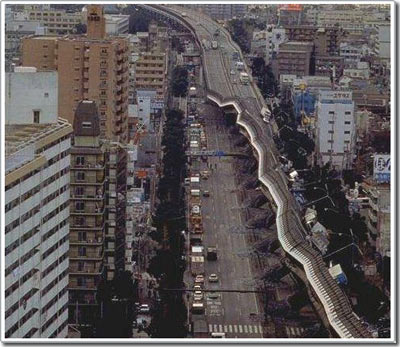Earthquake-proof concrete
Construction company Kajima (Japan) has successfully researched and manufactured " flexible concrete " that can withstand earthquakes. It is currently used in many high-rise buildings in Japan to combat seismic attacks. This type of concrete contains polymers thickened by human hair, often used in tires, woven together to prevent cracks spreading in concrete.
Instead of being bent and able to fall on one side with a high impact force after a crack like normal concrete, this concrete will make the building stronger if it is vibrated by earthquakes and still usually if there is an earthquake with great intensity.
Kajima company has spent 10 years researching " flexible concrete " and the product was introduced in 2003, but so far this type of concrete only accounts for 0.1% of the Japanese concrete market, partly due to the price Its height is 10 times that of ordinary concrete.
Japan is a country frequently hit by earthquakes, accounting for 20% of earthquakes with magnitudes greater than 6 Richter levels in the world.

The earthquake in Kobe (Japan) killed 6,400 people.The country's construction companies are working hard to research building materials that can withstand earthquakes to reduce human and property damage (Photo: Washington.edu).
MINH ANH
- Earthquake-proof bed
- Scientists have successfully developed a new type of concrete that is less prone to cracking than conventional concrete
- Concrete is devastatingly natural as much as plastic waste
- The road itself absorbs 4,000 liters of flooded water in a minute
- The new solution uses sparks to recycle concrete
- Story of concrete - king of construction materials
- Turning waste bricks into concrete
- Polymer concrete: concrete solution
- 2 Vietnamese original engineers invented extremely safe automatic deicing concrete
- Develop new mixed concrete from thermal power industry waste
- Vietnamese students won 2 prizes for the design of earthquake-proof houses
- Self-adhesive concrete
 Is the magnetic North Pole shift dangerous to humanity?
Is the magnetic North Pole shift dangerous to humanity? Washington legalizes the recycling of human bodies into fertilizer
Washington legalizes the recycling of human bodies into fertilizer Lightning stone - the mysterious guest
Lightning stone - the mysterious guest Stunned by the mysterious sunset, strange appearance
Stunned by the mysterious sunset, strange appearance Japan creates concrete that does not emit CO2
Japan creates concrete that does not emit CO2  The world's first carbon-absorbing concrete house
The world's first carbon-absorbing concrete house  The US military researches bio-concrete that self-heals damage from within
The US military researches bio-concrete that self-heals damage from within  Meta for artificial intelligence researching new ways to mix concrete
Meta for artificial intelligence researching new ways to mix concrete  Research and production of new super concrete from old tires
Research and production of new super concrete from old tires  Bio-receptive concrete promotes moss growth
Bio-receptive concrete promotes moss growth 